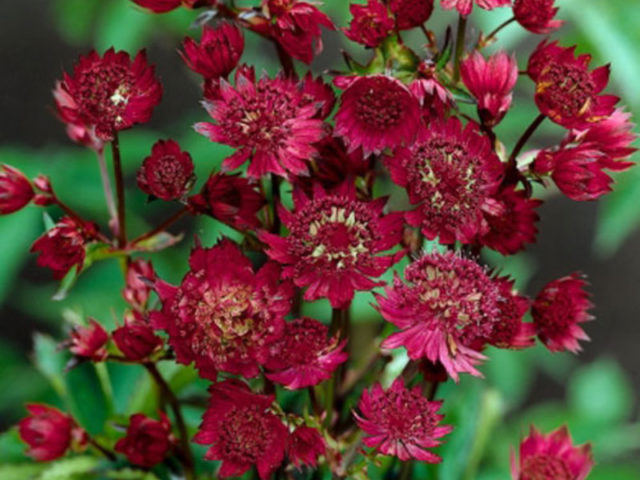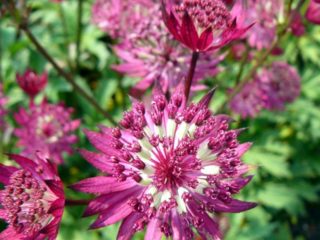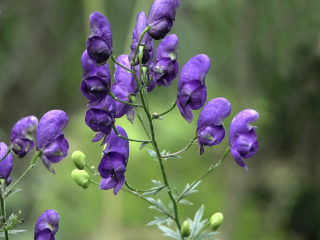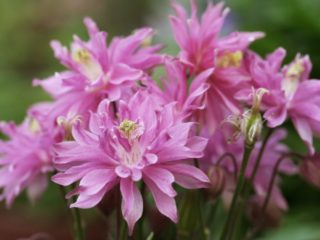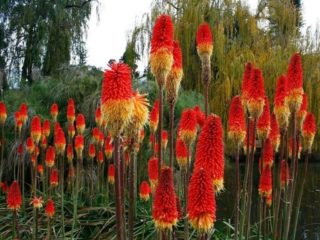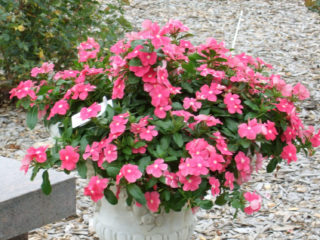Content
- 1 Astrantia flower description and characteristics
- 2 Astrantia winter hardiness
- 3 Types of astrania
- 4 Astrantia is large
- 4.1 Ruby Wedding
- 4.2 Description of astrania Moulin Rouge
- 4.3 Diva
- 4.4 Roma
- 4.5 Description of Astrania Claret
- 4.6 Lars
- 4.7 Hudspan Blood
- 4.8 Description of Astrantia Rosea
- 4.9 Alba
- 4.10 Buckland
- 4.11 Ruby Cloud
- 4.12 Sunningdale Variegata
- 4.13 Pink Symphony
- 4.14 Venice
- 4.15 Pink Pride
- 4.16 Abbey road
- 4.17 Snow Star
- 4.18 Shaggy
- 4.19 Sparkling Stars Pink
- 4.20 Pink joyce
- 4.21 Red Joyce
- 4.22 Billion Star
- 4.23 Purple Joyce
- 5 Astrantia maximum (largest)
- 6 Astrantia small
- 7 Astrantia carniola
- 8 Conclusion
- 9 Testimonials
Astrantia is a herbaceous flowering plant from the Umbrella family. Another name is Zvezdovka. Distributed throughout Europe and the Caucasus. The varieties and types of astrantia with the name are presented below.
Astrantia flower description and characteristics
Astrantia is a perennial flower actively used by gardeners as an ornamental flower.
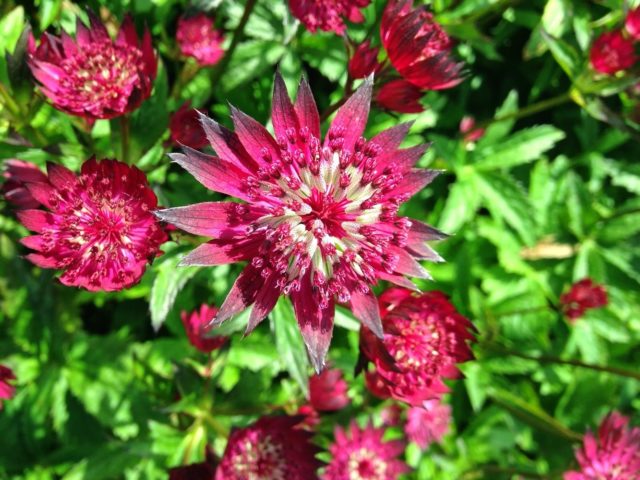
It is assumed that the plant got its name from the shape of the inflorescences that resemble stars.
The average height of the bush is 60 cm. Shoots are erect, branched at the base, low-branched. The rhizome is brown, creeping, close to the surface. The leaves are arranged in a circle, they are palmate-lobed or palmate-separated, consist of 3-7 lanceolate segments with jagged edges. The leaf plates are collected in root rosettes. The leaf petioles are thin and long.
During the flowering period, weakly leafy peduncles are formed, on the tops of which simple umbrella-shaped inflorescences are formed, resembling stars. They consist of many small white, pink, lilac or ruby flowers with pointed narrow bracts - wrappers. The leaves are bright green. In the middle of the inflorescences, buds of different sexes.
Long bloom - from May to early autumn. After flowering, a fruit is formed - a two-seeded oblong box.
The plant is used to create borders, planted in the center of lawns, in rabatki, in flower beds, in mixborders. The delicate inflorescences of Astrantia look harmoniously against the background of bright green foliage. They resemble stars or fireworks. The plant is versatile and goes well with many garden flowers.
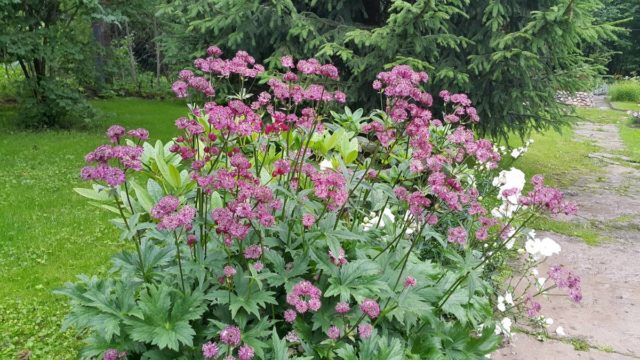
Due to its medium-sized flowers and compact bushes, the starlet perfectly complements any flower beds
The variety of colors allows you to combine it with large flowers, and in this case the contrast will be a very good solution.
The plant is used by florists to create bouquets. Astrantia can be both their base and complement to other colors. It looks especially impressive in purple compositions, creating an impression of lightness due to the shape of the flowers and their shades. The plant is suitable for both cutting and creating dry bouquets.
Astrantia belongs to unpretentious, drought and cold resistant plants. It grows well on garden soil, does not require any special conditions. It takes root well both in the shade and in a sunny meadow.
In the middle lane, Astrantia blooms in the open field from mid-June. If faded stems are removed in a timely manner, it can bloom again, at the end of summer, and delight until late autumn. The flowers of the second wave are usually less lush.
Young specimens develop very quickly. Astrantia does not require frequent transplants and grows in one place for up to 7 years.
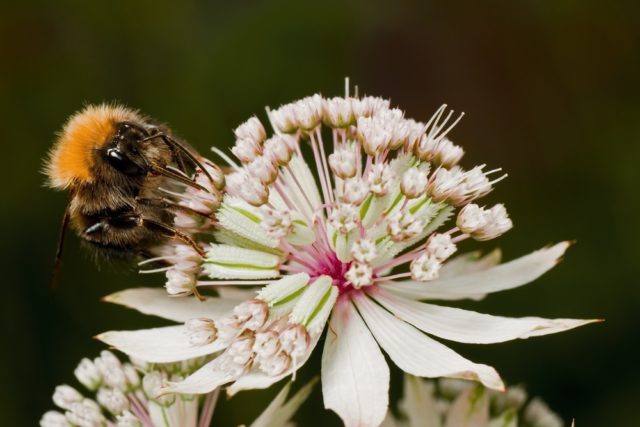
The flower is a honey plant that attracts bees
Astrantia winter hardiness
Astrantia belongs to the winter-hardy species, therefore, in the middle zone of the country it can winter without shelter. At the end of autumn, the bushes need to be cut off, leaving only the hemp. Then sprinkle with humus or peat. Young plants can suffer from frost, so they need to be mulched, and then covered with spruce branches.
According to experienced gardeners, Astrantia usually does not fail and endures cold weather without insulation.
Types of astrania
The Astrantia genus is represented by several species - there are about 10. In addition, thanks to breeders, many varieties of different colors have been bred - from white to dark purple. The middle can be in tone with the flower or in a contrasting shade.
Some varieties are distinguished by variegated leaves, which makes the plant decorative even without flowering. You can usually see pronounced white or yellow stripes along the edges.
Astrantia differ in height. Compact dwarf varieties grow up to only 15 cm, tall ones can reach 90 cm.
Astrantia is large
Another name for this perennial is large astrantia (major).
Under natural conditions, it is found in the Baltic States and Central Europe, in Moldova, Belarus, Ukraine, in the west of the European part of the Russian Federation. Grows on forest edges and lawns.
The bush is sprawling, reaches 70 cm in height, about 40 cm in diameter. Simple umbellate inflorescences, consisting of small light pink flowers, reach 5 cm in diameter. The leaves of the envelope are green or pinkish. Basal rosette consists of long-petiolate 3-7 palmate-separated leaves.
The popular varieties of Astrania major include many varieties.
Ruby Wedding
The bush is rather large, it will grow up to 60-80 cm in height. Flowers are dark cherry, ornamental leaves, dark green. Astrantia Ruby Wedding prefers shaded areas. Blooms profusely from June. The green leaf blades contrast well with the maroon flower heads.
Description of astrania Moulin Rouge
The variety has small, straight stems 50 cm high. Palm-shaped green leaves collected in a basal rosette are on long petioles. The plant is distinguished by wine-red inflorescences with a diameter of 4-5 cm and dark, almost black leaves of the wrapper. Specimens grown in sunny areas have more spectacular flowers. Astrantia Moulin Rouge begins to bloom in late June and ends in August.
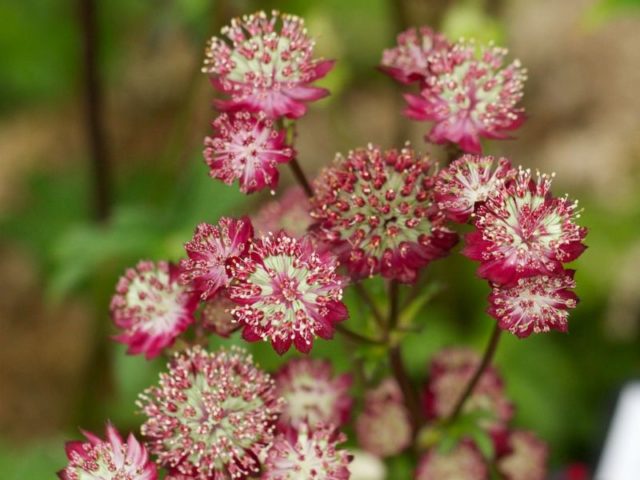
Specimens grown in sunny areas have more spectacular flowers.
Diva
Tall flower - grows up to 60-70 cm. Shoots are thin, slightly branched, leaves are bright green. Inflorescences reach 4 cm in diameter. It can grow both in the sun and in shaded places. Astrantia Diva blooms throughout the summer.
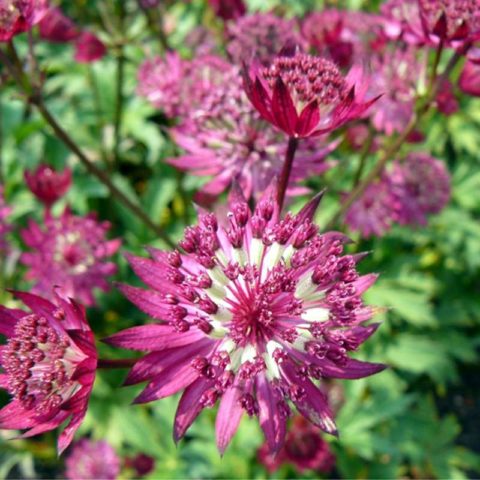
Differs in large burgundy or pink inflorescences
Roma
Plant height reaches 45-60 cm. Long-lasting, lush flowering. Large inflorescences are composed of delicate pink flowers. Astrantia Roma is well suited for creating garden compositions, for cutting and decorating winter bouquets.

Segmented large green leaves accentuate the beauty of exquisite umbrellas
Description of Astrania Claret
The height of the bush reaches 60 cm. Astrantia Claret is one of the darkest of the varieties with red flowers. The inflorescences are claret or wine-red, the wrapper is transparent, of the same color. Peduncles are violet-black. The leaves are narrow, bright green, young have a thin purple border along the jagged edge. Flowering time is from late June to October. This burgundy Astrantia is suitable for growing in containers and pots, as well as for creating bouquets.
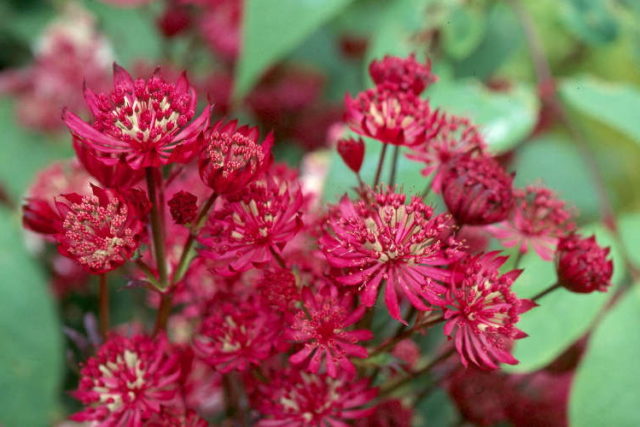
Claret prefers shade and partial shade
Lars
The plant reaches a height of 60 cm. The inflorescences are pink, the leaves are light green. Blooms in June and July.

Lars is well suited for cutting and creating bouquets
Hudspan Blood
Astrantia Hadspen Blood is distinguished by bright maroon or purple inflorescences. The bush is compact - up to 30-35 cm in height, and retains this size even in adulthood. Differs in long and lush flowering. Begins to bloom earlier than other varieties.Good for cutting.
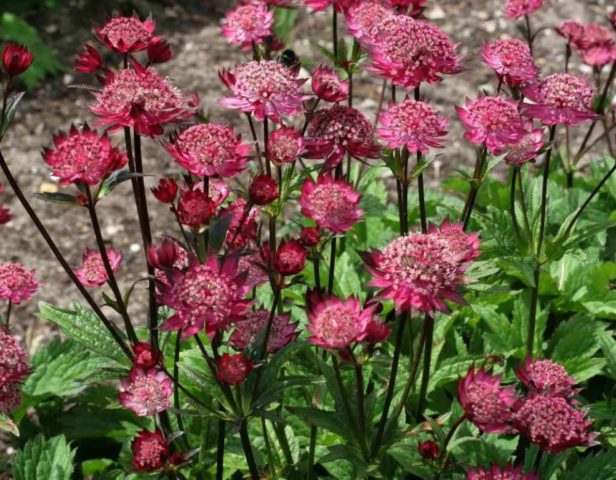
Hudspan Blood flowers are large, surrounded by wide bracts with an attractive vein.
Description of Astrantia Rosea
The bush grows up to 60-70 cm. The flower has spotted leaves, pastel pink simple inflorescences 5-7 cm in size, consisting of very small flowers, a reddish membranous wrapper. Leaves are sparse, palmate-five-dissected. Used both in group and single plantings, it is easy to combine with asters, hosts, lungwort, bells. Suitable for creating bouquets. Flowering time is from mid-June to mid-September.
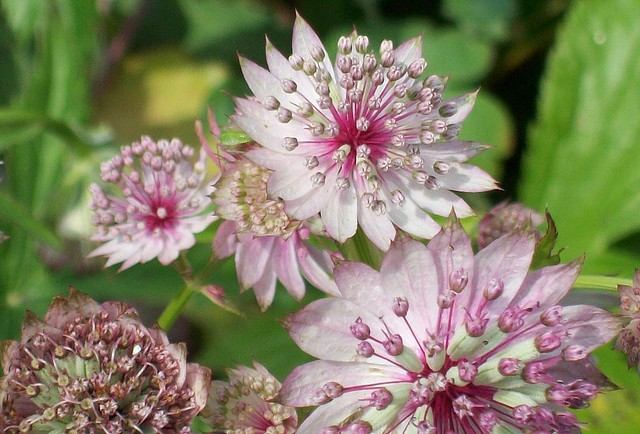
Rosea bush grows quickly, but is quite compact
Alba
Abundant and long flowering - from June to October. Astrantia Alba reaches a height of 60-75 cm. Shoots are practically leafless. The flowers are white-green, hemispherical, look great against the background of dark green foliage. The center is raised, surrounded by sharp bracts. The plant is unpretentious, takes root well on any soil, does not need fertilization, undemanding to light, grows for a long time in one place. In partial shade it blooms longer than in the sun. Moderate watering due to the small number of leaves. It can do without moisture, is not afraid of drought. Below in the photo is astrantia white Alba.
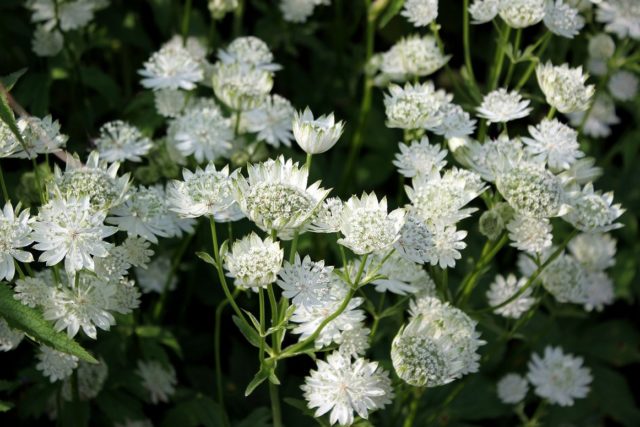
Alba is a tall variety with large inflorescences and original-shaped leaf blades
Buckland
Astrantia Buckland begins to bloom in June. Differs in a long flowering time, after pruning the shoots, it blooms again. Sprawling bushes, height - 70 cm, width - 35-40 cm. The flowers are light pink, 3.5-5 cm in diameter, the wrapper is green or pale pink.
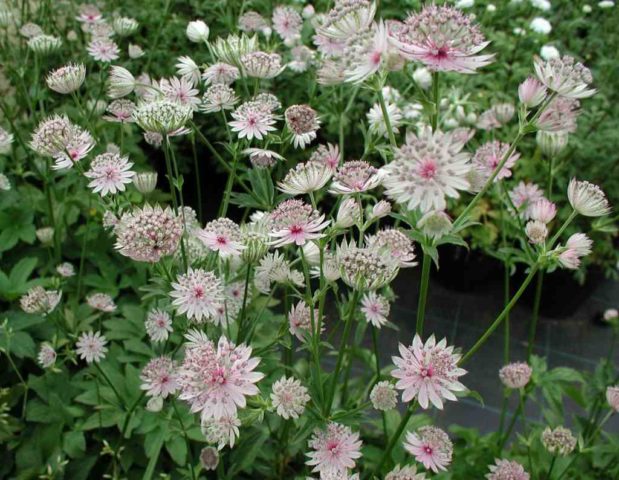
The plant retains decorative qualities throughout the season.
Ruby Cloud
The height of the bushes reaches 70 cm. The inflorescences are very bright, reddish-claret. Blooming buds are darker, the ends of the bracts usually remain green. Below is a photo of the Ruby Cloud Astrania.

Ruby Cloud blooms all summer
Sunningdale Variegata
The leaf plates are the main decoration of the Sunningdale Variegated Astrania. They are large, green, with yellowish and creamy spots. Inflorescences are delicate, pale lavender. Astrantia Variegata grows up to 60 cm. Flowering time - summer months. The leaves of the variegated astrantia are clearly visible in the photo.
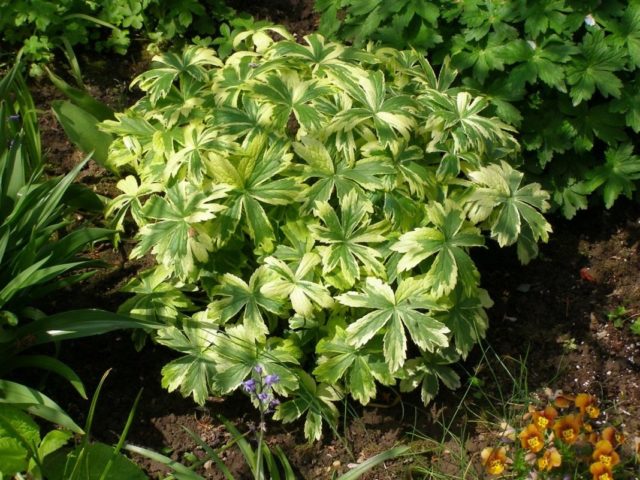
Sunningdale Variegata decorates the garden even without flowering
Pink Symphony
The bush grows up to 70 cm in height and 35-40 cm in diameter. This variety has pink-red flowers, pale pink wrappers. The inflorescences are dense, 3.5-5 cm in diameter. The basal leaves are palmate-separate, on long petioles. Astrantia Pink Symphony is suitable for winter bouquets and for cutting.
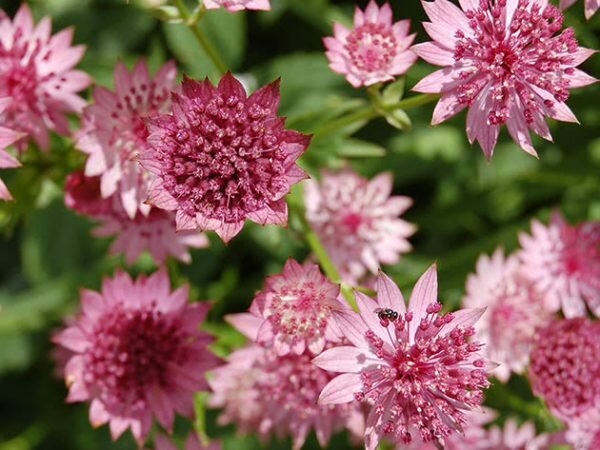
Grow a flower on lawns and mixborders in single and group planting
Venice
Astrantia Venice is a sprawling shrub with bright ruby-wine flowers and dense perianths that resemble a basket. The plant reaches 40 cm in width and 50-60 cm in height. The flower is profusely flowering, suitable for summer cutting and winter bouquets. Astrantia Venice prefers areas of the garden with sufficient moisture.
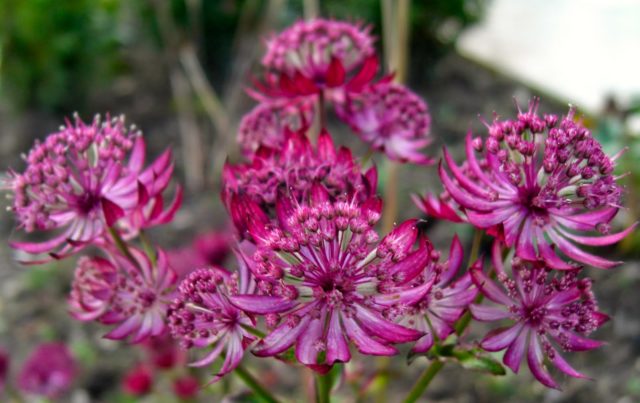
The inflorescences of Venice, consisting of numerous small flowers that look like pins, do not fade or lose their shape
Pink Pride
This flower is distinguished by bright pink inflorescences and palmate-lobed leaves. The bush reaches a height of 60 cm. It begins to bloom in June. Loves sunny places or partial shade.
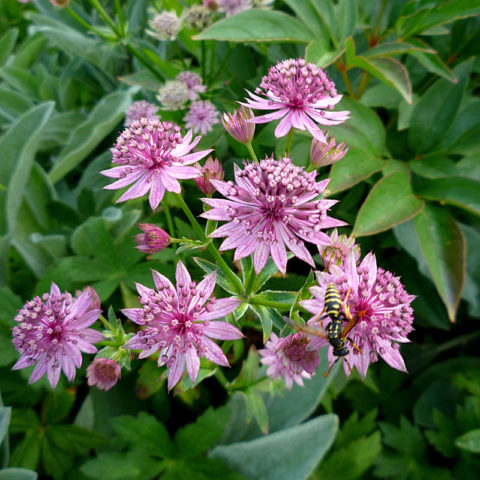
This variety retains its decorative effect after the end of flowering due to the preservation of color in the leaves of the wrapper.
Abbey road
A plant with pink-lilac flowers and pink-purple bracts. The wrapper leaves are darker in color. The leaf blades are palmate-lobed, dark green. The height of the bush is 60-70 cm. The flowering time is from June to August. Prefers sun or partial shade and drained, moist soils.

Suitable for growing in pots, for cutting and creating dry winter bouquets
Snow Star
A lush neat bush, densely covered with unusual flowers, looks good on the shore of a reservoir and in rockeries, suitable for group and single plantings. Plant height - from 30 to 60 cm.Inflorescences are white, similar to fluffy umbrellas, perianths are pointed, silvery-white, with greenish tips. Astrantia Snowstar blooms from June to September, retaining its attractiveness for a long time.

Snow Star is popular not only among landscape designers, but also among florists.
Shaggy
It can reach a height of 80 cm. Flowering time is from June to August. Astrantia Shaggy is distinguished by openwork carved leaves on long petioles and large white inflorescences with greenish patterns. Prefers loose fertile soils, tolerates drought and cold well. After removing the faded shoots, it can bloom a second time. The flower is suitable for growing on lawns in single or group planting. Astrantia Shaggy looks good in compositions with stones.
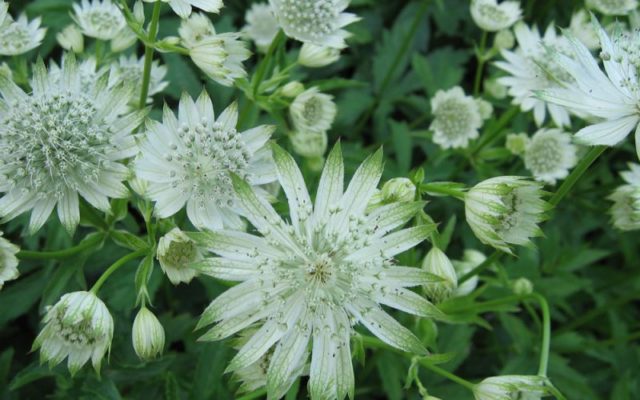
Sheggy's wrapper leaves are large, have a decorative appearance.
Sparkling Stars Pink
Astrantia Sparkling Stars Pink blooms from June to August. The bush grows up to 70 cm high and 40 cm wide. Prefers partial shade and moist, drained soil. Astrantia Sparkling Stars Pink is well suited for dried flowers and for cutting.

Inflorescences of Sparkling Stars Pink are pink, large - up to 5 cm in diameter.
Pink joyce
Astrantia Pink Joyce has bright pink flowers. The bush grows up to 60 cm in height. Blooms from June to August. Prefers a sunny place or partial shade, as well as a drained, moist soil.
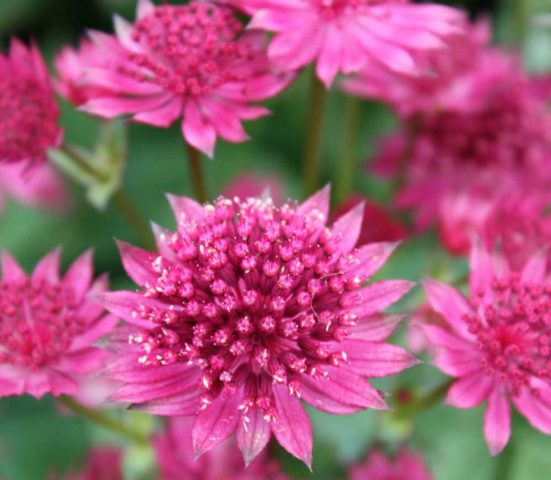
The plant is suitable for creating borders, for decorating a garden plot in a natural style
Red Joyce
Astrantia Red Joyce reaches 55 cm in height and 45 cm in width. Flowering time is from June to August. The leaves are bright green, in the spring you can see red highlights on them. Astrantia Red Joyce is the ideal plant for cutting and growing in containers. In the photo astrantia red Red Joyce.
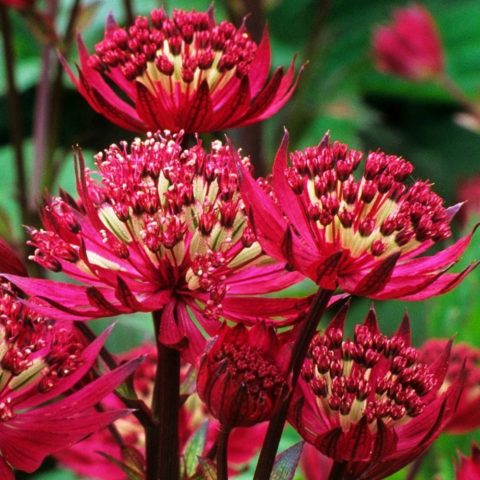
Flowers and bracts of Red Joyce are dark red, shiny
Billion Star
Billion Star Astrantia bush grows up to 50-100 cm in height and 40-60 cm in width. Finger-dissected leaves are arranged on long petioles.
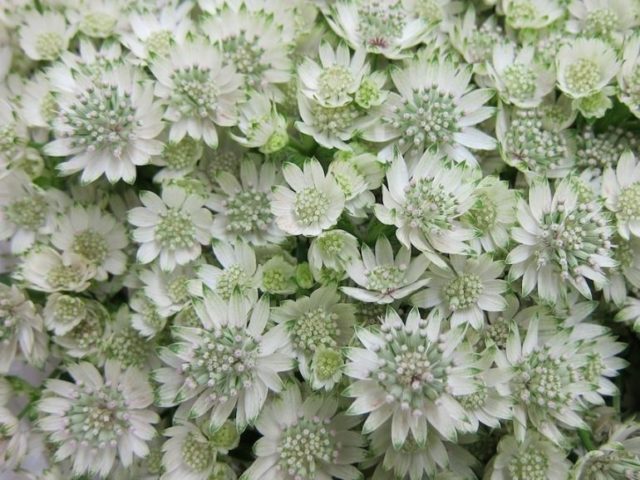
The flowers are creamy, 3.5 cm in diameter, the bracts are white with green tips
Purple Joyce
The bushes are dense, grow rapidly, reach a height of 60 cm. It blooms all summer - from June to September. According to reviews, Astrantia Pearl Joyce is popular with gardeners due to the rich color of the petals.
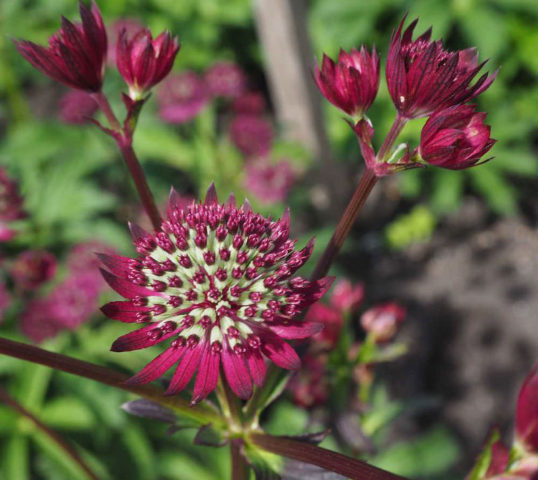
Flowers and bracts at Pearl Joyce are dark purple, shiny
Astrantia maximum (largest)
Astrantia is growing the largest in the Caucasus. Blooms in August and September. The height of the bush is about 70 cm. The plant has a long rhizome, tripartite leaves. The size of the inflorescences, consisting of small pink flowers, is 5-7 cm in diameter. The leaves of the wrapper are scarious, pale red.
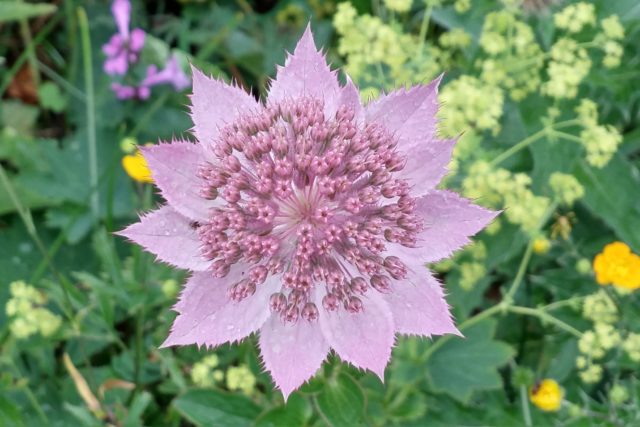
Zvezdovka maximum - a flower with high decorative effect
Astrantia small
The height of the bush reaches 15-30 cm. The plant has an airy appearance due to thin and tall flower shoots. Inflorescences are loose, up to 3 cm in diameter. They consist of many white flowers with curling long stamens. This species blooms in July and August.
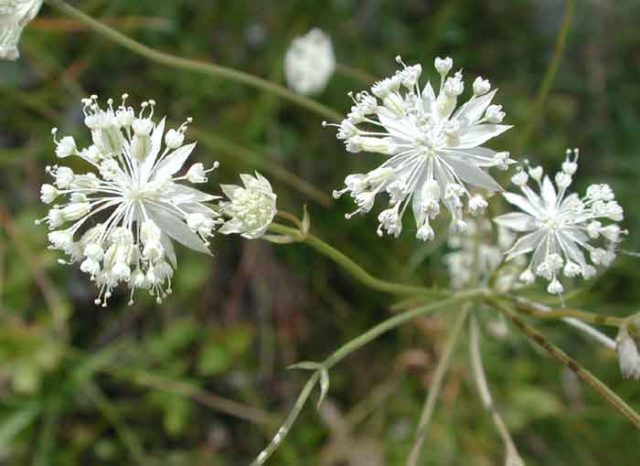
The plant is distinguished by small inflorescences, while it can grow up to 90 cm in height
Astrantia carniola
The species is rarely used in gardening. The bush grows up to 45-50 cm. The plant is distinguished by finger-separated dark green glossy leaves and small light inflorescences, reaching a diameter of about 3 cm. The bracts are very narrow and long.
Astrantia Karniolskaya Rubra is the most commonly cultivated variety of this species. The bush grows to a height of 70-90 cm. It begins to bloom in May and ends in August.
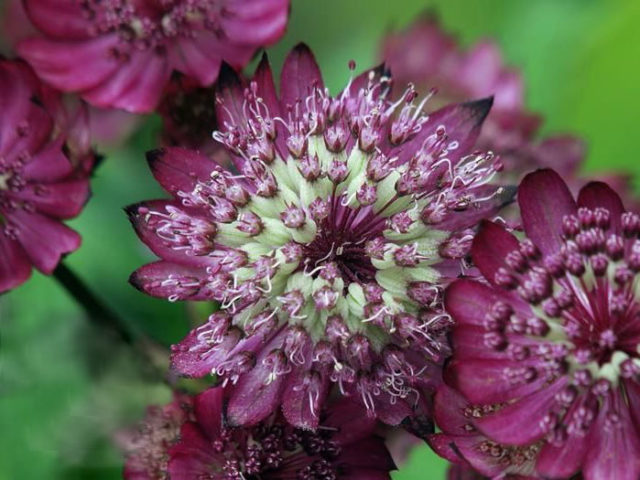
Rubra is distinguished by deep pink inflorescences and emerald green leaves.
Conclusion
Varieties and types of Astrantia with the name and photo give an idea of what these flowers look like. This will help with the choice of novice growers.
